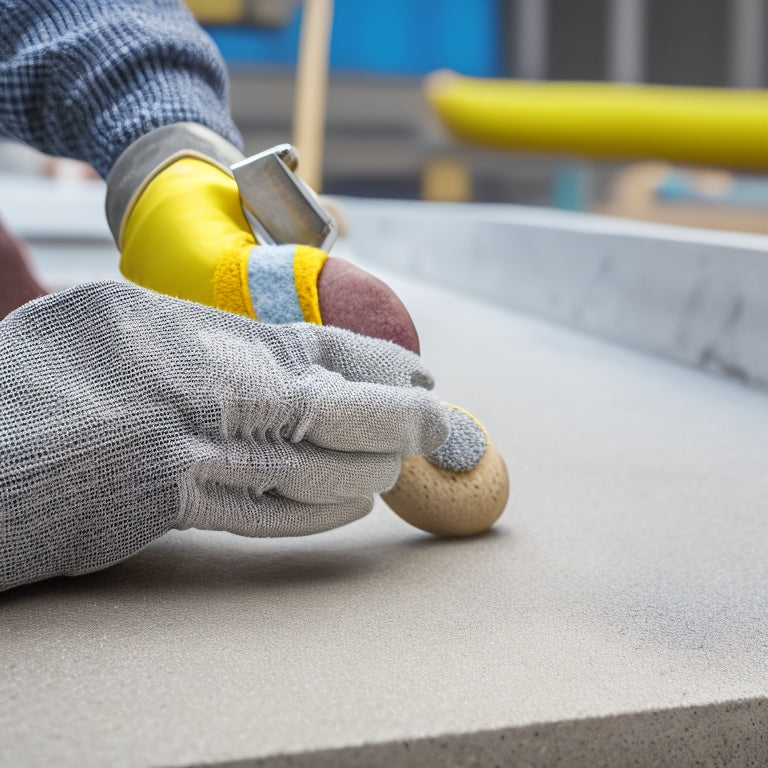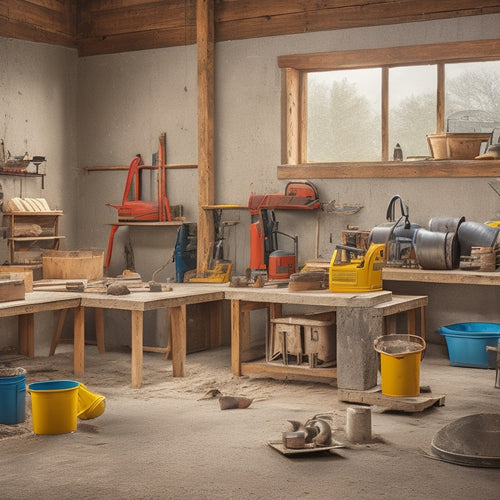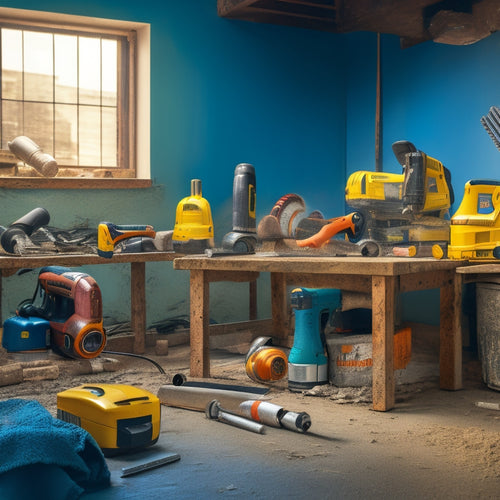
Why Choose the Right Concrete Adhesion Tools
Share
You need the right concrete adhesion tools to guarantee a strong, lasting bond between your bathroom's substrate and the materials you're working with, as using the wrong tools can lead to costly rework, damaged surfaces, and compromised structural integrity. Your bathroom's unique characteristics, such as moisture levels, substrate composition, and surface type, require tailored adhesion approaches. With the right tools, you can achieve peak bonding results, but with the wrong ones, you risk project delays and budget overruns. By understanding the key features, adhesive considerations, and tool quality requirements, you can make informed decisions that set your project up for success - and the details matter.
Key Takeaways
• Proper concrete adhesion tools ensure a strong bond, reducing the risk of project failure and costly repairs.
• The right tools adapt to concrete surface variations, ensuring optimal adhesion and minimizing material waste.
• Using the correct tool for concrete adhesion prevents damage to the surface, saving time and resources on repairs.
• High-quality tools provide consistent results, increasing efficiency and reducing labor costs in the long run.
• Investing in the right concrete adhesion tools prevents frequent replacements, reducing overall project expenses.
Understanding Your Bathroom's Needs
Before selecting a concrete adhesion tool for your bathroom renovation, you must identify the specific demands of your bathroom, including its size, moisture levels, and substrate composition. This assessment will help you determine the most appropriate tool for the job.
You must evaluate the bathroom surfaces that will be involved in the renovation. Are they concrete, ceramic, or natural stone? Each surface requires a unique approach to guarantee ideal adhesion. For instance, natural stone requires a more delicate touch to prevent damage, while concrete demands a more aggressive bonding agent.
Moisture resistance is another critical factor to evaluate. Bathrooms are inherently humid environments, and the adhesion tool you choose must be able to withstand these conditions. Look for tools with moisture-resistant properties to guarantee a strong bond that won't compromise over time.
Key Features to Look For
Now that you've assessed your bathroom's unique demands, you can focus on identifying the key features to look for in a concrete adhesion tool that will effectively address those needs. When selecting a tool, consider the adhesion techniques it employs and the level of surface preparation it requires. A tool that can adapt to different surface conditions and adhesion techniques will provide more versatility and better results.
Here are some key features to look for:
| Feature | Description |
|---|---|
| Adjustable Pressure | Allows for tailored pressure application to suit different surface types and adhesion techniques |
| Interchangeable Tips | Enables the use of various tip designs and materials for ideal surface preparation and adhesion |
| Ergonomic Design | Reduces user fatigue and improves control, enabling more precise application and better results |
Adhesive Type and Purpose
When selecting a concrete adhesion tool, you must take into account the type of adhesive it's designed to work with, as different adhesives serve distinct purposes and require specific application techniques.
For instance, epoxy-based adhesives are ideal for high-stress applications, while acrylic-based adhesives are better suited for general-purpose bonding. Understanding the adhesive properties is vital, as it affects the tool's performance and the overall bonding process.
You'll need to take into account the adhesive's viscosity, pot life, and open time, as these factors impact the application techniques.
For example, a low-viscosity adhesive may require a specialized tool with precision nozzles to guarantee accurate application. On the other hand, a high-viscosity adhesive may necessitate a tool with increased pressure to guarantee proper flow.
Tool Quality and Durability
Your concrete adhesion tool's quality and durability directly impact its performance. A high-quality tool guarantees consistent and accurate application, while a low-quality one can lead to uneven bonding and compromised structural integrity.
When selecting a tool, you should prioritize durable materials that can withstand the demands of the job site. For instance, stainless steel or high-carbon steel tools are more resistant to corrosion and wear than those made from lower-grade materials. Additionally, consider the tool's design and construction, making sure it's built to withstand the rigors of repeated use.
Proper maintenance practices are also essential in extending the tool's lifespan. Regularly clean and inspect your tool to prevent the buildup of debris and adhesives, which can compromise its performance. Store your tool in a dry, protected area to prevent damage from environmental factors.
Budget and Value Considerations
As you weigh your options for a concrete adhesion tool, consider the budget you've allocated for the purchase and assess whether the tool's performance and features justify its cost. A cost comparison between different tools can help you identify the best value for your investment.
When conducting an investment analysis, consider not only the initial purchase price but also the tool's expected lifespan, maintenance costs, and potential replacement parts.
It's essential to evaluate the tool's features and performance in relation to its cost. A cheaper tool may seem like a good deal upfront, but if it breaks easily or requires frequent replacement, it may end up costing you more in the long run.
On the other hand, a more expensive tool with superior quality and durability may be a better investment, even if it requires a larger upfront payment.
Frequently Asked Questions
Can I Use a Single Tool for All Concrete Adhesion Tasks?
When tackling concrete adhesion tasks, you're likely wondering if a single tool can handle everything.
While it's tempting to opt for a versatile tool, task specificity is essential. Different tasks require unique features and precision.
Using a single tool for all tasks can compromise results and even lead to damage.
Instead, invest in a range of tools that cater to specific tasks, ensuring ideal performance and precision.
How Often Should I Clean and Maintain My Adhesion Tools?
You're wise to prioritize tool maintenance.
Determine your cleaning frequency based on usage: daily for heavy use, weekly for moderate, and monthly for light.
Follow these maintenance tips: clean tools with a wire brush and mild detergent, dry thoroughly to prevent rust, and store them in a dry place.
Regular maintenance guarantees your tools remain effective and extends their lifespan.
Are There Any Safety Precautions I Should Take When Using Adhesion Tools?
When using adhesion tools, you must prioritize your safety above all else.
You should always wear protective equipment, such as gloves and safety glasses, to prevent injuries.
Additionally, guarantee safe handling by maintaining a firm grip on the tool and keeping your work area clean and clear of debris.
Failure to do so can result in accidents and damage to the tool or surrounding surfaces.
Can I Use Concrete Adhesion Tools on Other Materials Besides Concrete?
You're wondering if you can use concrete adhesion tools on alternative materials besides concrete.
The answer is, it depends. While these tools are designed for concrete, you can attempt to use them on other materials, but adhesion effectiveness will vary.
You'll need to take into account the material's porosity, texture, and chemical composition to guarantee a strong bond.
It's essential to test the tool on a small area first to avoid compromising the material or the tool itself.
Are There Any Industry Standards for Concrete Adhesion Tool Quality?
When evaluating concrete adhesion tools, you'll want to verify they meet industry standards for quality.
Look for tools that adhere to ASTM and ISO guidelines, which assess tool durability and adhesive performance.
These standards guarantee the tool can withstand harsh environments and provide reliable bonding results.
Conclusion
As you stand in your newly renovated bathroom, you hold the master key to a fortress of durability - the right concrete adhesion tools.
Like a master builder, you've laid the foundation for a long-lasting sanctuary.
Just as a strong bond between bricks holds a fortress together, the right tools guarantee a rock-solid bond between concrete and tile, safeguarding your haven from the ravages of time and water.
Related Posts
-

What Tools to Rent for a Concrete Home Reno
When tackling a concrete home renovation, you'll need to rent a variety of specialized tools to get the job done. For...
-

Top Concrete Resurfacing Tools for a Pro Finish
When it comes to achieving a professional finish in concrete resurfacing projects, you require the right set of speci...
-

Essential Power Tools for Concrete Block Construction
When building with concrete blocks, you'll need a range of power tools to cut, drill, mix, and finish the blocks to g...


